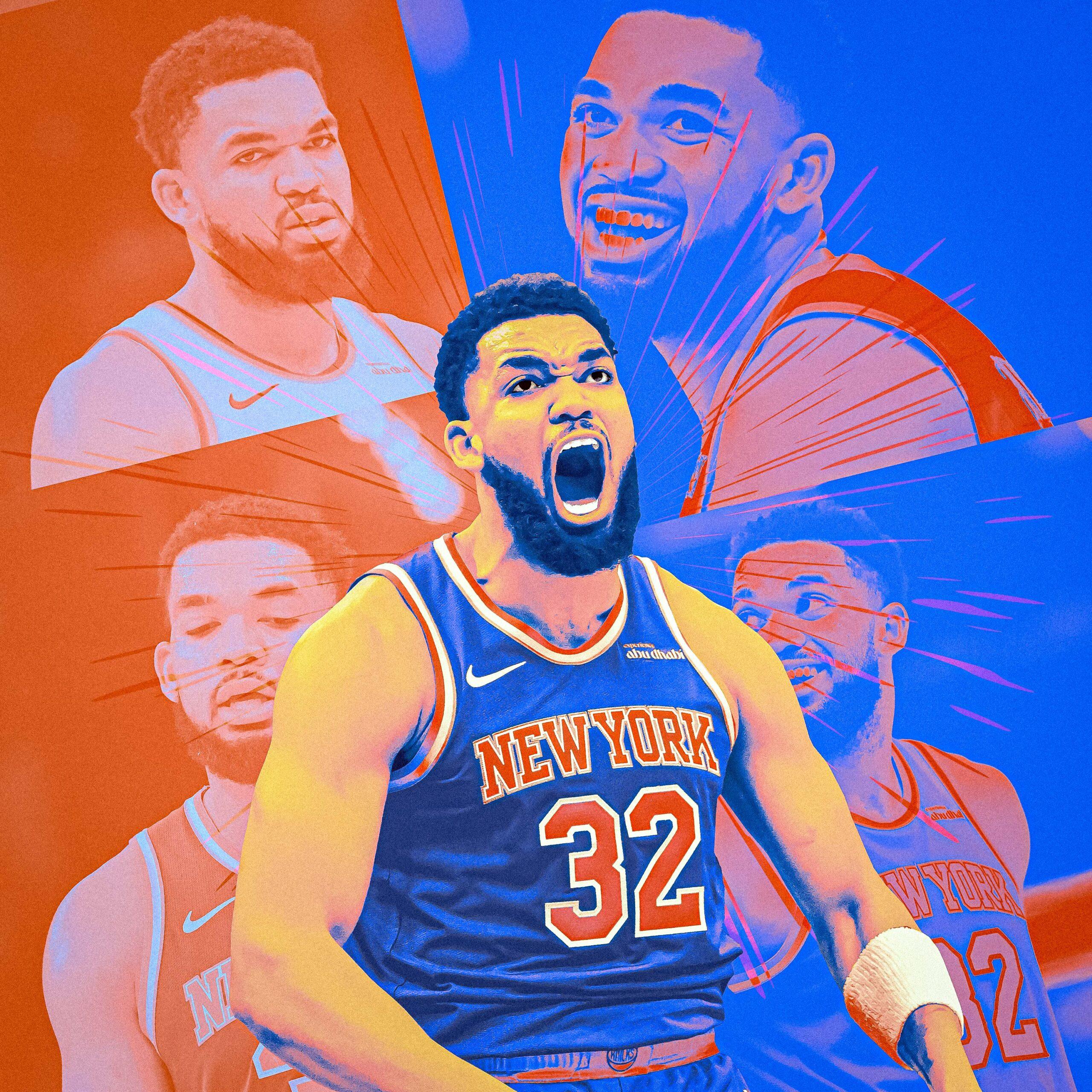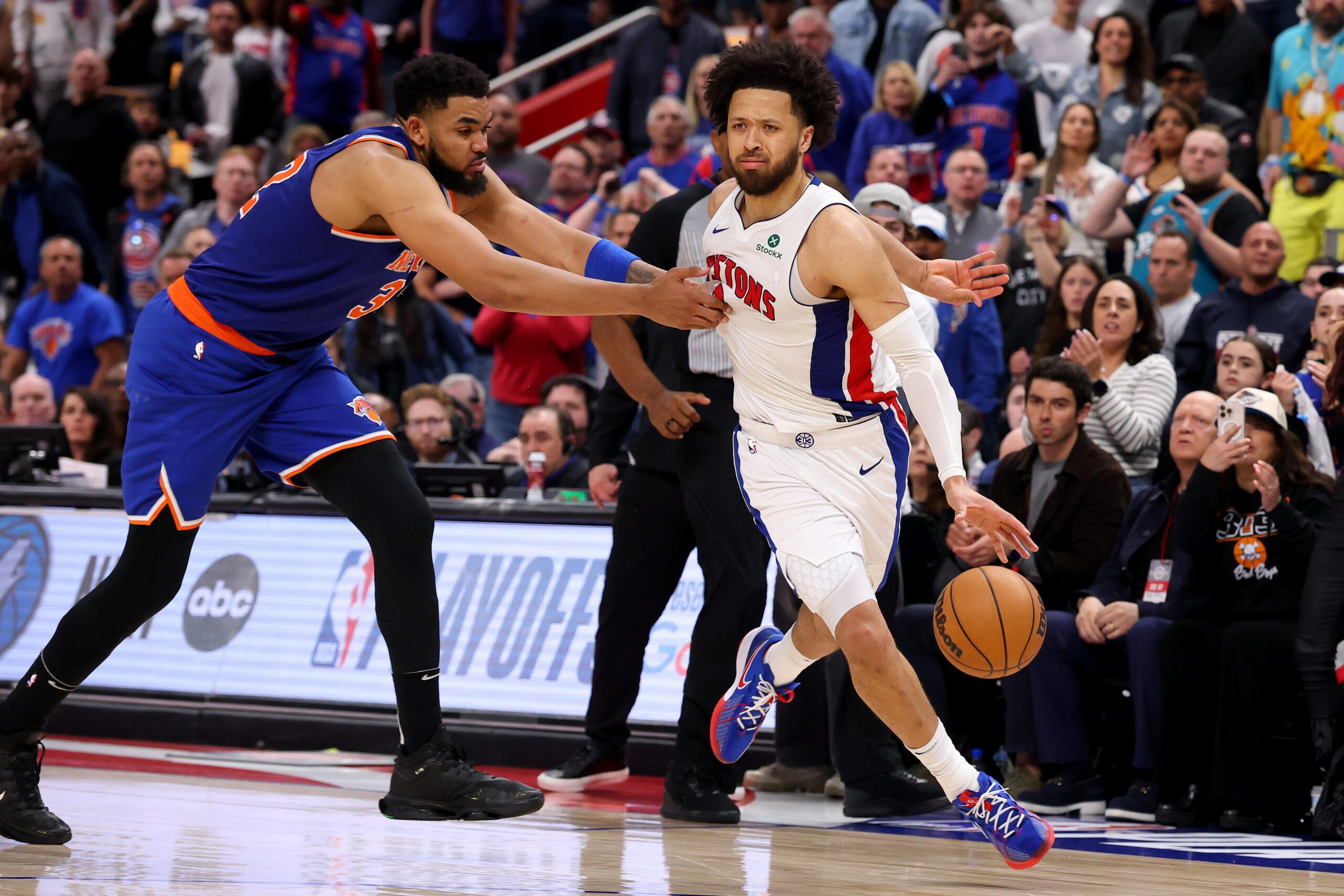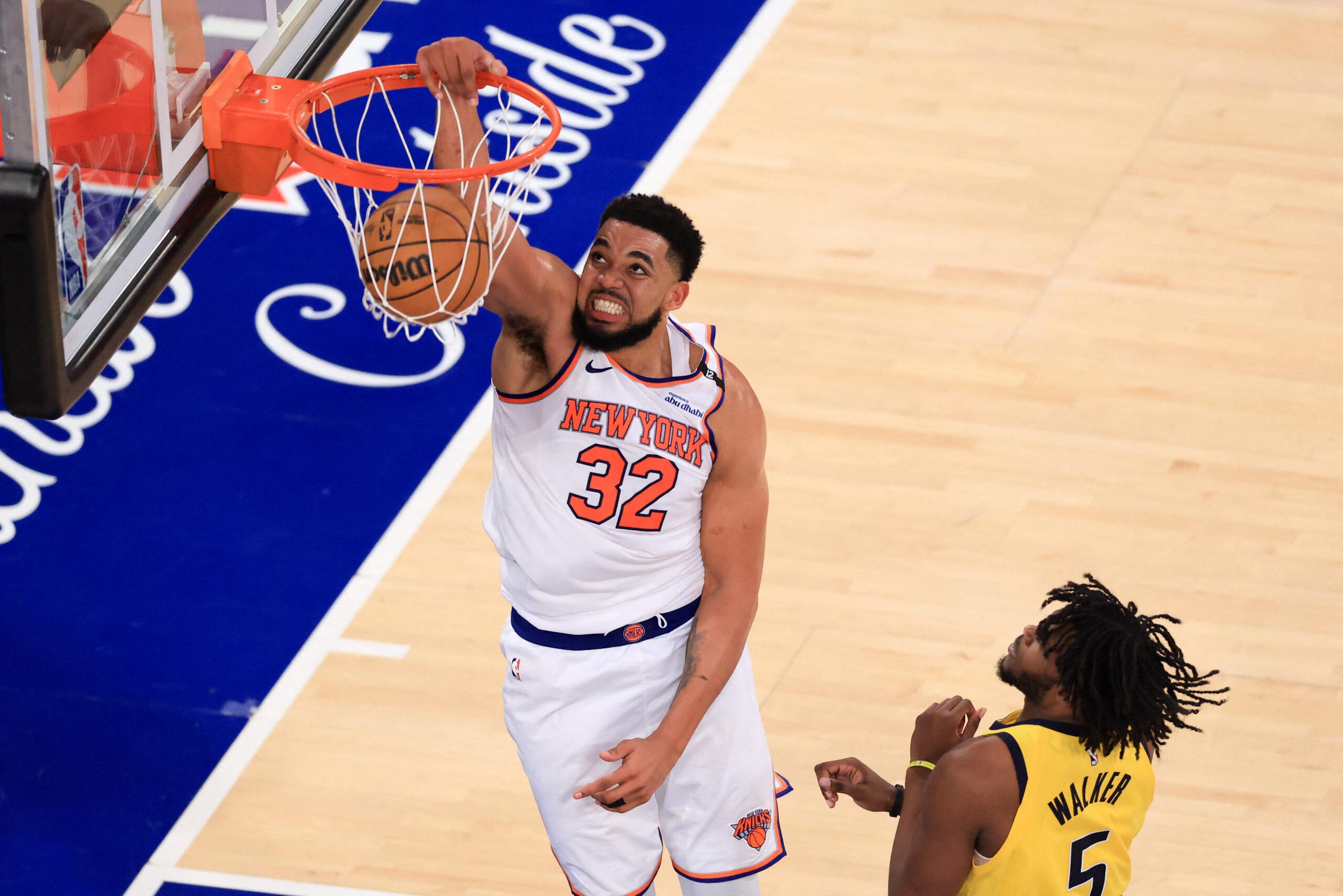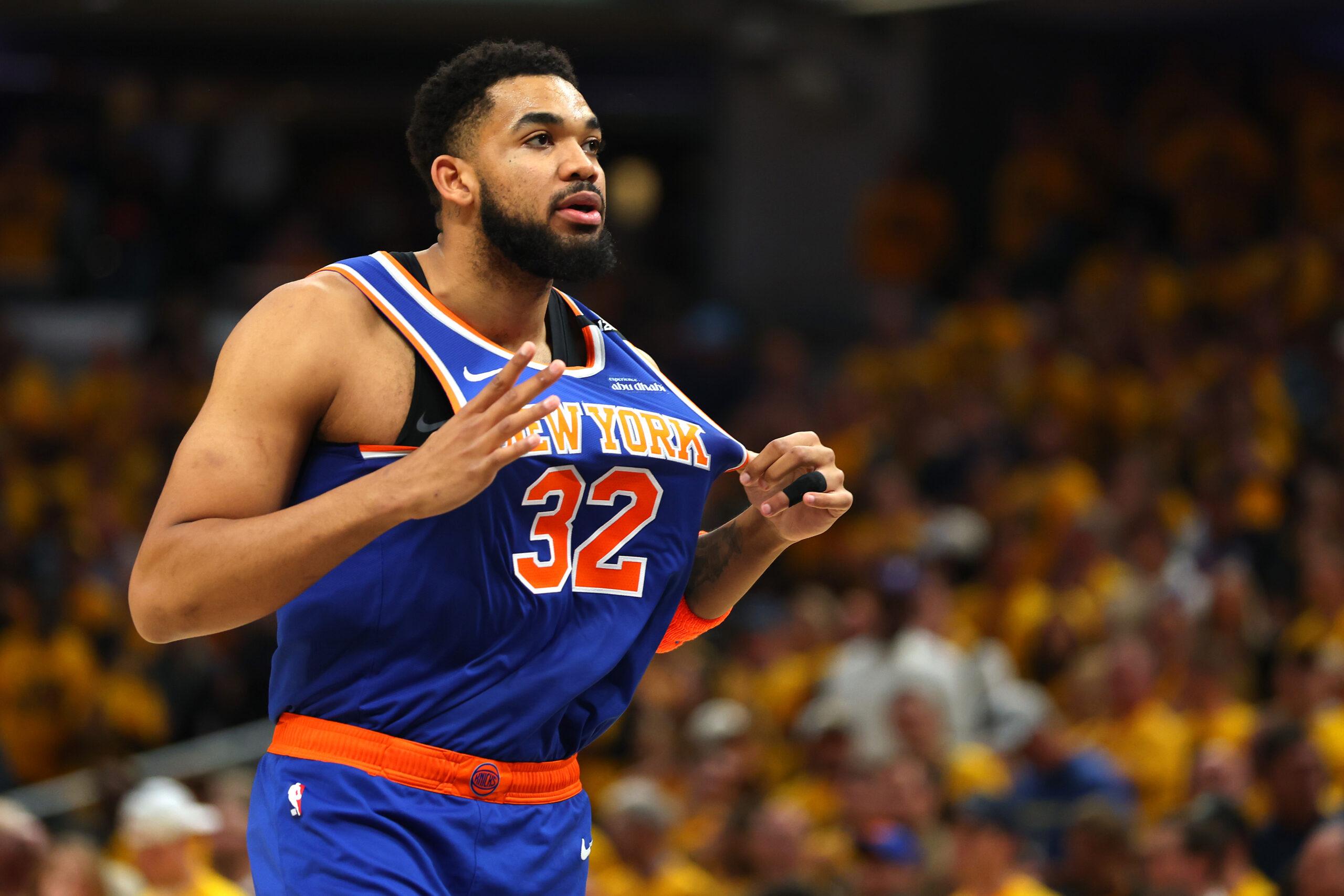
At the tail end of the third quarter of Game 5 between the New York Knicks and Indiana Pacers, TNT broadcaster and former NBA coach Stan Van Gundy issued a warning. The Knicks were about to inbound the ball with a 17-point lead and 0.6 seconds on the clock, and New York coach Tom Thibodeau was taking the opportunity to sub in his top two scorers. “I hate to say this,” Van Gundy piped up, sounding more like he loved to say this, “and I understand why he's doing it. But! I wouldn’t bring Karl-Anthony Towns back into the game for this last possession. He does some crazy things.”
This sounded like the kind of worry one might have about a deep bench player or a volatile rookie—not a five-time All-Star who was averaging a double-double deep into the NBA playoffs and who’d already posted 19 points in Game 5. But Van Gundy’s concern with Towns wasn’t about his production. It was about his lack of restraint. “He could set an illegal screen right here!” Van Gundy argued as the rest of the booth remained silent, and to be fair, Towns had already racked up four fouls by that point, at least half of them dopey. “If you’re gonna have him out there, spot him up—do not let him set a screen right now.”
On the ensuing play, Towns put up a midrange airball, pleaded for a foul, and, phew, successfully avoided setting any illegal screens. And in the fourth quarter, the Knicks tuned out all the nervous chuckles, held strong in the face of a few Pacers challenges to their double-digit lead, and came away with a 111-94 win. That cut the Pacers’ series lead to 3-2 and gave the Knicks a fresh lease on life as they head to Indianapolis to try to steal Game 6. “Do or die,” said Towns, who had been listed as questionable before Game 5 because of a knee injury but finished the night with 24 points, 13 rebounds, three assists, one steal, four turnovers, and five fouls. (Towns’s box scores are best scanned with this face.)
After the game, the Inside the NBA fellas sat down with Towns on their set and inquired about his knee, about how he decides when to shoot and when to drive, about the Knicks bench—and finally, about what they really wanted to know.
“Well, I gotta say something,” Charles Barkley began. “I gotta criticize you, man. Why are you getting those dumb fouls?”
Towns’s response was earnest, if helpless. “God only knows,” he said. When he asked whether there was a specific game they were referring to, Shaquille O’Neal just shook his head. “Every game,” he said. “Every game, nephew.”

Back in October, when Towns popped off for a double-double in his first home game as a new Knick, the big man immediately became, and has stubbornly remained, one of my favorite avatars for this strange you-can-just-do-things throwback of a New York season. Drafted first overall by the Minnesota Timberwolves in 2015, Towns had helped the Wolves make it to the Western Conference finals last May. (That playoff run included a big Towns performance to beat the Nuggets in seven, and it also included Anthony Edwards publicly and amiably begging Towns to foul less. Some things never change.) But on the eve of this NBA season, Towns was abruptly traded to the Knicks in exchange for Julius Randle and Donte DiVincenzo. He later said that the move left him “flabbergasted.”
At the time, I questioned whether he could or would thrive in New York. Towns seemed like a gentle soul—what would the city’s potentially sour vibe do to his spirit? His Madison Square Garden debut against the Indiana Pacers (!) wound up being a pretty good indication of the answer.
By the end of the 2024-25 regular season, Towns had averaged 24.4 points, 12.8 rebounds, and at least one all-time nickname (take a meow, Bodega KAT) as the Knicks turned in their first back-to-back 50-win seasons since the good old days. I watched the 7-foot-tall Towns pull down rebounds, put up sweet little close-range hook shots, and launch daggers from downtown. Sometimes he was surprisingly deft, and sometimes he was reliably daft, and oftentimes he displayed both attributes on the very same play. Still, whether I was praising or cursing Towns, one thing has stayed the same: The guy sure captures my imagination.
So why is it that I find the guy himself so difficult to capture?
Writing about Towns is an exercise in trying and failing not to make one or both of us sound like big ol’ weirdos. Karl-Anthony Towns, I first wrote and erased, is a mild-mannered man of extremes, a hulking 7-footer who’s trying on a 7-year-old’s idea of a mean mug for size. That sounded gratuitous and, well, kinda mean, even if I do feel that Towns’s exaggerated expressions are an important aspect of his whole unlikely package. So I tried again, seeking to capture not his looks, but his play, like the seasoned sportswriter that I supposedly am. Towns, I wrote, is a hulking 7-footer who drives through the lane like he’s a Game of Thrones wildling giant sauntering his way over a battlefield.
OK, maybe not the most flattering comparison, but genuinely one I think of anytime I see Towns storm past multiple doomed defenders with one and a half of those signature slo-mo strides. And hey, it’s probably less of a neg than the other mental image that I associate with Towns and made a fumbling attempt to put into words: a fledgling bird of prey who presents as a jumble of knees and feathers until you catch that first glimpse of his glorious, powerful wingspan.
Yeah, see what I mean? Big ol’ weirdos, writer and subject alike.
The thing is, I’ve come to find out that maybe this is the gist with Towns and that it’s exactly what makes him so special. The man has certainly received more, ah, normal-sounding plaudits over the past decade: During his Rookie of the Year season with the Timberwolves, for example, he was voted the player NBA GMs would “most like to build around.” But looking over the more recent work of colleagues near and far, I see that maybe I’m not alone in my wacky ways of describing Towns.
What really sings, for instance, are descriptors of KAT like “hasty tableau of aggravation” (Michael Pina, last May) and verbs that explain his play like “lurching” (Zach Lowe, this week). What really resonates are the vivid, unforgettable images of Towns as “a deflating car dealership tube man” (Giri Nathan, the other day and also every day for the rest of my life). When the TNT postgame crew welcomed Towns to their set on Thursday night with the remark “You’re the only basketball player I know that has good-looking feet,” I appreciated their contribution to the genre. When I read that Towns’s coach on the Wolves referred to his occasional short circuits as generating “stray voltage,” I felt that spark of recognition.
And listening to the below exchange on a recent Ryen Russillo Podcast, I smiled from ear to ear, suddenly too blessed to be stressed that the New York Knicks still have to climb out of a 3-2 hole against the Indiana Pacers.
Russillo: How would you describe KAT to someone who’s just getting into basketball?
Brian Windhorst: [Nods gravely.] Yeah. [Chooses words carefully.] Um, he’s an awkward guy. [Blasts off on multi-minute spiel that involves the phrases “very high waist,” “Steve Urkel,” “sprawled on the ground like a spider,” “unusual mannerisms,” and “super-duper crazy-talented.”] So, that’s how I would describe him. I don’t know if you agree or not.
Russillo: Uh, I love that it started with the high waist thing.

When Windy put it that way, I could almost forget that less than 24 hours before that pod, I’d had the sudden realization that there was a tiny but nonzero chance that the Towns era in New York was … already over. That I might not get to see the big lug—that mild-mannered man of extremes, that wildling, that aw-shucks fledgling—in a Knicks jersey ever again. The open questions surrounding him ranged from the medical (How’s that knee?) to the philosophical (Can this Knicks team, as constructed, ever win it all?) to the transactional (Could the Knicks use Towns as a way to get Giannis Antetokounmpo to New York?).
“Once a Knick, always a Knick,” the franchise likes to say about everyone but Charles Oakley, but I for one would be glum if such a one-of-one character turned out to be one and done with the organization. Yes, he has quirks and foibles—but so does Thibodeau! Yes, he’s expensive—I have no comeback for that one. Yes, he’s no Jalen Brunson. But also, isn’t that the point?
All season long, two things proved to be true about Towns: (1) He has a real good head on his shoulders, and (2) more often than not, he also has his head in the clouds. (A true porque no los dos of you can’t coach that stuff.) But in the first round of these playoffs, as he was busy nailing a go-ahead 3 in Game 4 against the Pistons, a third truism began to emerge: Whatever direction Towns is heading in, the rest of the Knicks are likely to follow. Brunson may be the Knicks’ heart and soul, Josh Hart may be the spiritual and numerical successor of John Starks, and Mikal Bridges may be the midrange X factor. But it’s Towns whose play has been the shorthand for the team’s bigger story. If the Knicks want to keep playing, he’ll have to be the talk of the town.
Many NBA players—Brunson among them—thrive on their obvious dynamism, but Towns has a different and more distinctive style of movement, more lugubrious, a set of skills that draws you forward in your seat and murmurs to you that if you can be patient, there’s more where that came from. (Usually, this plays as a promise, but at times, like when Towns is racking up first-quarter fouls, it seems like a threat.)
Over the past few weeks, a lot of NBA stars have been playing something like hockey, but not Towns. Watching him is more like watching someone struggle through five sets of tennis, marooned out there on center court, fucking up but also still throwing down, tasked with battling his opponent and the heat and himself. It’s fascinating and frustrating, several hours of character study and First Take fodder. All he can do is all he can do. All he can take is his next shot. God only knows.

One messed-up thing about Knicks fans is that a great many of us inexplicably harbor a hopeless optimist within. (Elation and Extrapolation: A Survey of Knicks Enthusiasm, From Bing Bong to Z-Bo is the working title of my graduate thesis on this subject.) And my own optimist appeared in overtime of Game 1 against the Pacers just as an errant basketball careened in the direction of Towns with the Knicks down 3 and almost no time left on the clock. It didn’t matter that the Knicks had already blown a historic lead at home that night or that Brunson had just airballed a 3-point attempt of his own. It mattered that Towns, with his big Gumby-bodied jumper, was about to have a chance to make everything right.
Reader, I didn’t merely think that he’d tie the game to force another overtime that the Knicks would go on to win. I knew it. I heard the choirs of angels. I saw Timothée Chalamet’s trembling LET’S GO face. I sensed the bedlam about to rise inside MSG. I tipped my cap to the trickster hoops apparitions that had apparently engineered this whole Rube Goldberg contraption of a playoff game, all recursive references and zany angles, just so this moment could occur.
Then Towns missed, and the Knicks lost, and I crashed back to Earth. But you know what? I know what I saw.
There’s been a lot more to see since, much of it ugly. Game 2 of the ECF ruined my Friday night. I watched Game 3 on an airplane, making a small scene with my little ughs (first half) and silent fist pumps (fourth quarter). That was the game when Towns saved the Knicks’ season, finishing with 24 points, 20 of them in the fourth quarter. (He also turned the ball over six times.) That night had the cadence of a highlight film but also a whiff of foreboding, like glimpsing an ominous newsreel early on in a disaster film. And indeed, in the Knicks’ Game 4 loss, there was one 90-second stretch in the third quarter in which Towns missed a hook shot, missed a floater, stepped back and missed a chaotic 3-pointer, grabbed a huge rebound on the other side of the floor, made an attempt that even the dry NBA play-by-play report zestily categorized as a “7-foot driving, floating bank jump shot,” got fouled on the play, and buried the free throw. It was unforgivably sloppy, secretly a little bit fun—and, in the end, all for naught.
On Thursday night, before the TNT crew started hassling Towns about his biggest flaw, they gave him partial credit for New York’s team effort. The last three sets of teammates to each average more than 20 points in the first five games of a conference final, apparently, were Jerry West and Elgin Baylor in 1966, Kobe and Shaq in 2002 … and Towns and Brunson this season.
I admire Brunson because he plays like a set of fireworks going off in someone’s hand. But I’m flat-out fascinated by Towns because he isn’t that kind of explosive. All of his propulsive energy takes the form of a slower burn, a constant unfurling, a really long stride. He bends toward illogical conclusions, his footsteps warping the floor into an uncanny valley. Is he some big ol’ oddity, or has everyone else just gotten small? Watching Towns play, I sometimes can’t tell whether I’m gasping or scoffing. And I don’t think I’ll ever know how to describe the Karl-Anthony Towns experience any more clearly than that.
Luckily for me, though, Van Gundy sure did. “He does some crazy things,” the former coach said on Thursday night. And that’s exactly why I want Towns out on the court.

